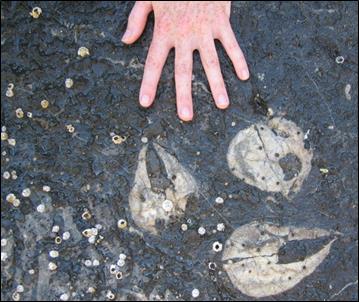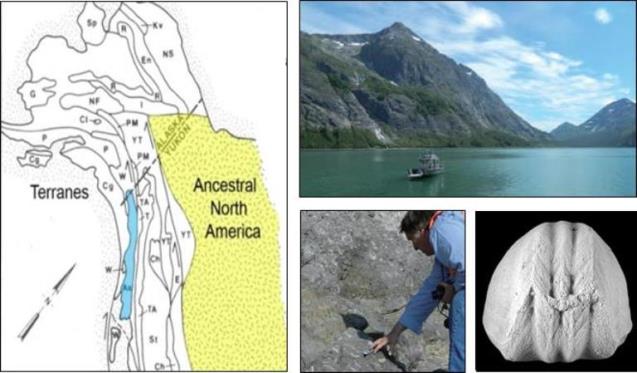How significant are Glacier Bay’s paleontological resources?
Project Dates
2011-2012
Did You Know?
“Terranes” are massive groups of rocks that were carried long distances by plate tectonic forces and eventually accreted onto a continental margin. They are sometimes called “exotic terranes”. Fossils found in Southeast Alaska’s Alexander Terrane are unknown in the rest of North America. They are most similar to fossils found in Siberia and the Ural Mountains.
Introduction

As the retreat of ice in Glacier Bay created new landscapes, it also revealed extremely ancient ones. In the 1890s, around the same time that John Burroughs was marveling at strange landscapes that “world-shaping forces. . .had built but yesterday”, Henry Platt Cushing was examining Paleozoic-era fossils on Drake Island. In fact, while Glacier Bay is celebrated for its glaciers, its fossil resources are a lesser known but very significant—perhaps world-class—feature.
The rocks forming most of the trough of Glacier Bay date to the Paleozoic era. The Willoughby Limestone, the oldest rock formation in Glacier Bay, was formed some 425 million years ago in the Silurian period. The Willoughby Limestone and associated formations may represent the thickest known sequence of Silurian rocks in North America, and perhaps the world. The huge, spectacular fossils preserved in the formation indicate that it formed in a very productive, warm, and shallow marine environment.
The Alexander Terrane, a belt of rocks that includes the Willoughby Formation, makes up much of Southeast Alaska. Fossil evidence suggests that the terrane was once part of Siberia. The terrane split off about 300 million years ago and was transported long distances by oceanic plate tectonic motion. Eventually, perhaps 100 million years ago, the terrane smashed against the North American continental plate.
Recognizing a need to more fully document Glacier Bay’s significant fossil resources, this project was designed with two objectives: (1) to develop a paleontological database archiving all known fossil data from Glacier Bay, and (2) to conduct field work in order to better refine the stratigraphy, age correlation, and faunal content of Paleozoic rock units exposed along the shoreline of lower Glacier Bay.
Methods
The researcher created a paleontological database for the park consisting of a complete bibliography of all relevant published and unpublished studies and a spreadsheet containing all known fossil citations in the literature. This is the first such compilation for any NPS unit in Alaska. The researcher visited the Smithsonian Institution to review their extensive collection of Glacier Bay fossils that were collected decades ago.
In the second phase the researcher and his colleagues spent two weeks in 2011 visiting shoreline exposures in lower Glacier Bay to collect fossils and get a better understanding of the area’s Paleozoic fauna and stratigraphy. Future work will involve systematic study of the collected fossils with the aim of providing better age control, and improved paleoecological and paleobiogeographical knowledge of Glacier Bay’s ancient fauna.
Findings

The researcher documented 580 fossil locations in Glacier Bay. As a result of field investigations, the researchers have revised the accepted stratigraphic succession for Glacier Bay. The study provided additional confirmation of the Siberian origins of the fossil Silurian fauna of the Alexander terrane. The researchers discovered and described a new species of brachiopod in 2011.
Other paleontological resources documented in the park include the well-studied Cenozoic age (10 million-25 million year old) fossils in the Lituya Bay area. LaPerouse remarked on finding these fossils in 1786—this was the first mention of fossils in Alaska.
Learn More
Alaska Paleontological Database at www.Alaskafossil.org.
Last updated: September 13, 2016
